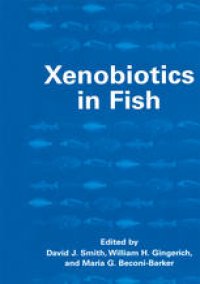
Ebook: Xenobiotics in Fish
Author: Rosalie A. Schnick (auth.) David J. Smith William H. Gingerich Maria G. Beconi-Barker (eds.)
- Tags: Freshwater & Marine Ecology, Food Science, Veterinary Medicine, Animal Systematics/Taxonomy/Biogeography
- Year: 1999
- Publisher: Springer US
- Edition: 1
- Language: English
- pdf
Aquaculture is rapidly becoming a major source of fish protein used to meet the nutritional needs of humans. As the aquaculture industry grows, exposure of farmed fish to environmental contaminants, and the need for chemical therapeutic agents for fish, will increase. This book is designed to bring together authorities worldwide on the regulation of environmental contaminants and food chemicals and researchers investigating the metabolism and disposition of foreign chemicals (xenobiotics) in fish species.
Aquaculture is rapidly becoming a major source of fish protein used to meet the nutritional needs of humans. As the aquaculture industry grows, exposure of farmed fish to environmental contaminants, and the need for chemical therapeutic agents for fish, will increase. This book is designed to bring together authorities worldwide on the regulation of environmental contaminants and food chemicals and researchers investigating the metabolism and disposition of foreign chemicals (xenobiotics) in fish species.
Aquaculture is rapidly becoming a major source of fish protein used to meet the nutritional needs of humans. As the aquaculture industry grows, exposure of farmed fish to environmental contaminants, and the need for chemical therapeutic agents for fish, will increase. This book is designed to bring together authorities worldwide on the regulation of environmental contaminants and food chemicals and researchers investigating the metabolism and disposition of foreign chemicals (xenobiotics) in fish species.
Content:
Front Matter....Pages i-viii
Use of Chemicals in Fish Management and Fish Culture....Pages 1-14
U.S. Food and Drug Administration’s Perspective on Aquaculture Drug Residues....Pages 15-23
Requirements for the Approval of Veterinary Therapeutics or Growth Enhancers Used in Fish Production....Pages 25-38
Pesticide Bioaccumulation and Metabolism....Pages 39-54
Considerations in Compartmental Pharmacokinetic Modeling in Fish....Pages 55-72
Pharmacokinetic Modeling in Aquatic Animals....Pages 73-86
Recent Advances in the Development and Use of Physiologically Based Toxicokinetic Models for Fish....Pages 87-103
A Physiologically Based Pharmacokinetic Model for Predicting the Withdrawal Period of Oxytetracycline in Cultured Chinook Salmon (Oncorhynchus Tshawytscha) ....Pages 105-121
Comparative Pharmacokinetics of Sarafloxacin in Rainbow Trout and Channel Catfish....Pages 123-131
Predicting the Toxicokinetics of Trifluralin in Rainbow Trout Using Clearance-Volume Pharmacokinetic Models....Pages 133-148
Disposition and Metabolism of Malachite Green and Other Therapeutic Dyes in Fish....Pages 149-166
Uptake, Metabolism, and Elimination of Niclosamide by Fish....Pages 167-176
Uptake, Metabolism, and Elimination of TFM by Fish....Pages 177-187
Metabolism, Elimination, and Pharmacokinetics of the Fish Anesthetic Benzocaine....Pages 189-200
Metabolism and Pharmacokinetics of Sulfamonomethoxine in Edible Fish Species....Pages 201-212
Back Matter....Pages 213-223
Aquaculture is rapidly becoming a major source of fish protein used to meet the nutritional needs of humans. As the aquaculture industry grows, exposure of farmed fish to environmental contaminants, and the need for chemical therapeutic agents for fish, will increase. This book is designed to bring together authorities worldwide on the regulation of environmental contaminants and food chemicals and researchers investigating the metabolism and disposition of foreign chemicals (xenobiotics) in fish species.
Content:
Front Matter....Pages i-viii
Use of Chemicals in Fish Management and Fish Culture....Pages 1-14
U.S. Food and Drug Administration’s Perspective on Aquaculture Drug Residues....Pages 15-23
Requirements for the Approval of Veterinary Therapeutics or Growth Enhancers Used in Fish Production....Pages 25-38
Pesticide Bioaccumulation and Metabolism....Pages 39-54
Considerations in Compartmental Pharmacokinetic Modeling in Fish....Pages 55-72
Pharmacokinetic Modeling in Aquatic Animals....Pages 73-86
Recent Advances in the Development and Use of Physiologically Based Toxicokinetic Models for Fish....Pages 87-103
A Physiologically Based Pharmacokinetic Model for Predicting the Withdrawal Period of Oxytetracycline in Cultured Chinook Salmon (Oncorhynchus Tshawytscha) ....Pages 105-121
Comparative Pharmacokinetics of Sarafloxacin in Rainbow Trout and Channel Catfish....Pages 123-131
Predicting the Toxicokinetics of Trifluralin in Rainbow Trout Using Clearance-Volume Pharmacokinetic Models....Pages 133-148
Disposition and Metabolism of Malachite Green and Other Therapeutic Dyes in Fish....Pages 149-166
Uptake, Metabolism, and Elimination of Niclosamide by Fish....Pages 167-176
Uptake, Metabolism, and Elimination of TFM by Fish....Pages 177-187
Metabolism, Elimination, and Pharmacokinetics of the Fish Anesthetic Benzocaine....Pages 189-200
Metabolism and Pharmacokinetics of Sulfamonomethoxine in Edible Fish Species....Pages 201-212
Back Matter....Pages 213-223
....
Download the book Xenobiotics in Fish for free or read online
Continue reading on any device:

Last viewed books
Related books
{related-news}
Comments (0)